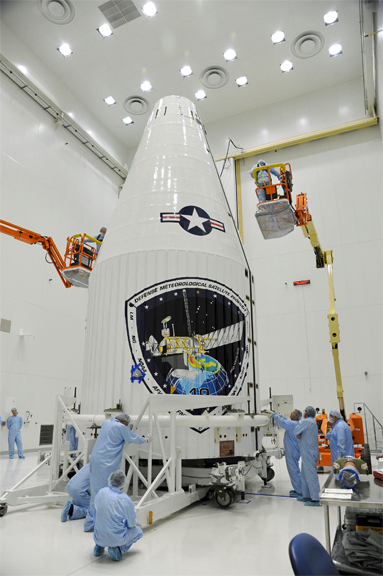
DSMP-19 is encapsulated within the fairing.
Photo courtesy of Lockheed Martin.
[SatNews] A Defense Meteorological Satellite Program (DMSP) satellite built by Lockheed Martin [NYSE: LMT] has been encapsulated into its payload fairing in preparation for an April 3rd liftoff—the launch will take place aboard an Atlas V rocket from Space Launch Complex 3 East at Vandenberg Air Force Base, California.
DMSP satellites collect data that enables military forecasters to find, track and forecast weather systems all over the globe, particularly in remote and hostile areas for deployed troops. Additionally, DMSP supports a broad range of civil users with sensing capabilities not provided by U.S. civil and international weather satellite systems.
“Weather guides some of the most important decisions in the armed forces, from flight patterns to troop movements. Through DMSP, we’re helping to provide safer, successful military missions,” said Sue Stretch, DMSP program director at Lockheed Martin. “Our satellite build and test process went flawlessly. As we approach launch, we are ready to continue serving this mission for the military and civil agencies that depend on it.”
DMSP satellites fulfill the country’s most critical requirements for global atmospheric, oceanic, terrestrial and space environment information. DMSP-19 is the fourth Block 5D-3 version to be launched, and Lockheed Martin has produced more than 40 satellites throughout the program’s 50-year history. Many of the satellites are performing beyond their design life, so refreshing on-orbit capability is important for reliable weather information. DMSP-19 is equipped with a sophisticated sensor suite that can capture visible and infrared cloud cover; measure precipitation, surface temperature and soil moisture; and collect specialized global meteorological, oceanographic and solar-geophysical information in all weather conditions.
The approaching launch is the first in five years for DMSP. The previous one was October 18, 2009, when DMSP-18 joined the constellation. The DMSP program is led by the U.S. Air Force Space and Missile Systems Center at Los Angeles Air Force Base, California, and control is provided by a joint team of the U.S. Air Force and the National Oceanic and Atmospheric Administration in Suitland, Maryland. All DMSP satellites were integrated and tested at the Lockheed Martin Space Systems facility in Sunnyvale, Calif.
Headquartered in Bethesda, Maryland, Lockheed Martin is a global security and aerospace company that employs approximately 115,000 people worldwide and is principally engaged in the research, design, development, manufacture, integration and sustainment of advanced technology systems, products and services. The Corporation’s net sales for 2013 were $45.4 billion.
There's more information at http://lockheedmartin.com/dmsp
News posting regarding the DSMP encapsulation from March 19, 2014, from the USAF Air Force Space Command's Space & Missile Systems Center:
The U.S. Air Force, Lockheed Martin, Northrop Grumman and United Launch Alliance (ULA) team have successfully moved one step closer to the launching of the 19th Defense Meteorological Satellite Program (DMSP) block 5D weather satellite.

The DSMP satellite,image courtesy of Lockheed Martin.
On March 14 engineers completed spacecraft encapsulation within the launch fairing at Vandenberg Air Force Base. The DMSP-19 encapsulation within the Atlas V launch vehicle payload fairing represents an important milestone for the DMSP-19 launch campaign. This event marks the completion of spacecraft integration, functional testing and compatibility checks with the Air Force Satellite Control Network (AFSCN). The final phase of the DMSP-19 launch integration process is set to take place. The encapsulated payload will be carried on a transporter to the launch pad. Once at the launch pad, the payload fairing assembly will be lifted and integrated onto the 57 meter tall Atlas V launch vehicle. The Atlas is developed by ULA, headquartered in Denver, Colorado. DMSP-19 is scheduled to launch on April 3, 2014. This will be the second time a DMSP satellite is launched with an Atlas V rocket.
"Weather guides some of the most important decisions in the armed forces, from flight patterns to troop movements. Through DMSP, we're helping to provide safer, successful missions. We are ready to continue serving this mission for the military and civil agencies that depend on it."—Sue Stretch, DMSP program director at Lockheed Martin.
- DMSP-19 is the fourth Block 5D-3 version to be launched
- Lockheed Martin has produced more than 40 satellites throughout the program's 50-year history
For the past 50 years, the DMSP satellites have been the primary provider of terrestrial and space weather information to the US military. DMSP satellites have fulfilled the military's most critical requirements for global atmospheric, oceanic, terrestrial, and space environment information. DMSP sensors provide imagery in visible, infrared and microwave bands to enhance information available to the warfighter. Through these satellites, military users find, track and forecast weather systems over remote and hostile areas for deployed troops. The Air Force Space Command's Space and Missile Systems Center, located at Los Angeles Air Force Base, Calif.ornia, is the U.S. Air Force's center of acquisition excellence for acquiring and developing military space systems. Its portfolio includes GPS, military satellite communications, defense meteorological satellites, space launch and range systems, satellite control networks, space based infrared systems and space situational awareness capabilities.

